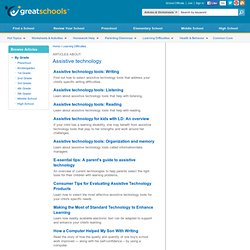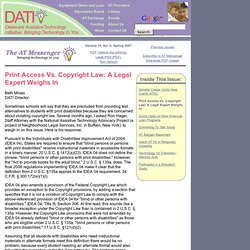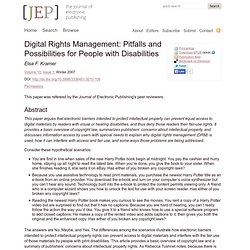

Assistive Technology and Mild Disabilities. A Glimpse at Current Teaching Practices with Preliminary Survey Results. Effective Teaching Practices and the Barriers Limiting Their Use in Accessing the Curriculum: A Review of Recent Literature. Assitive Technololgy: A Parent's Guide. Assistive Technology Tools - GreatSchools.org.
Assistive technology tools: Writing Find out how to select assistive technology tools that address your child's specific writing difficulties.

Assistive technology tools: Listening Learn about assistive technology tools that help with listening. Assistive technology tools: Reading Learn about assistive technology tools that help with reading. Assistive technology for kids with LD: An overview If your child has a learning disability, she may benefit from assistive technology tools that play to her strengths and work around her challenges. Assistive technology tools: Organization and memory Learn about assistive technology tools called information/data managers. E-ssential tips: A parent's guide to assistive technology An overview of current technologies to help parents select the right tools for their children with learning problems.
Consumer Tips for Evaluating Assistive Technology Products Learn how to select the most effective assistive technology tools for your child's specific needs. Assistive Technology Tools - GreatSchools.org. Print Access and Copyright Law. Beth Mineo DATI Director Sometimes schools will say that they are precluded from providing text alternatives to students with print disabilities because they are concerned about violating copyright law.

Several months ago, I asked Ron Hager, Staff Attorney with the National Assistive Technology Advocacy Project (a project of Neighborhood Legal Services, Inc. in Buffalo, New York), to weigh in on this issue. Here is his response: Pursuant to the Individuals with Disabilities Improvement Act of 2004 (IDEA 04), States are required to ensure that "blind persons or persons with print disabilities" receive instructional materials in accessible formats in a timely manner. 20 U.S.C. § 1412(a)(23).
IDEA 04 does not define the phrase, "blind persons or other persons with print disabilities. " 1. All four categories listed above require that a person's eligibility be certified by "competent authority. " 2. A big “thank you” to Ron for his insightful analysis of this complex issue! Digital Rights Management: Pitfalls and Possibilities for People with Disabilities. This paper was refereed by the Journal of Electronic Publishing's peer reviewers.

Abstract This paper argues that electronic barriers intended to protect intellectual property can prevent equal access to digital materials by readers with visual or hearing disabilities, and thus deny those readers their fair-use rights. It provides a basic overview of copyright law, summarizes publishers’ concerns about intellectual property, and discusses information access by users with special needs to explain why digital rights management (DRM) is used, how it can interfere with access and fair use, and some ways those problems are being addressed. Consider these hypothetical scenarios: You are first in line when sales of the new Harry Potter book begin at midnight. The answers are No, Maybe, and Yes. Disability Law and Copyright Publishers rely on copyright laws primarily to protect their works from unauthorized reproduction or redistribution. The Chafee Amendment to the U.S. Some Responses to DRM.